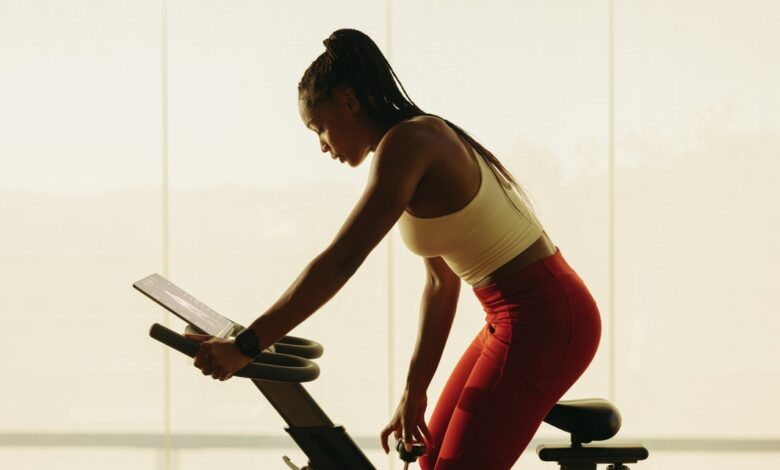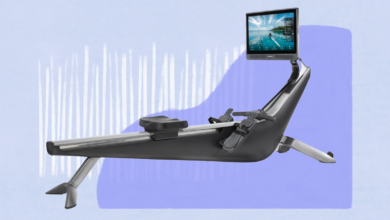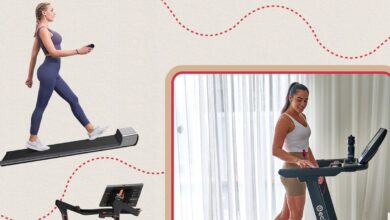Does Indoor Cycling ‘Count’ as Strength Training—or Is It Just Cardio?

When I step off the bike after a particularly intense cycling class, my legs can sometimes feel a little wobbly. Especially if the instructor programmed some major hill work with lots of resistance, my quads will be quivering, and I just know they’re gonna ache tomorrow. Honestly, after I’ve pedaled that hard, I can’t help but wonder: Could cycling “count” as leg day?
I know I’m not the only one who’s ever questioned whether a tough Peloton session technically gives me a two-for-one workout deal. Burning out your leg muscles on those hill climbs has to build strength, right? Well, SELF tapped a handful of experts to find out exactly what cycling can do for your body, and how it compares to a dedicated strength workout full of squats and deadlifts.
All in all, indoor cycling gives you a major lower-body challenge without ticking off your joints.
Cycling is a fantastic way to get your heart rate up and improve your endurance in a joint-friendly way. “You’re going to get amazing cardiovascular benefits in a cycling class,” ACE-certified personal trainer Jason Schneider, the western regional group fitness manager at Crunch Fitness and a USA Cycling coach, tells SELF. He points out that doctors often recommend cycling to older adults or those with joint issues. Not only does it help improve the range of motion for your hip, knee, and ankle joints, but because it’s low impact, it’s easier on your body than other cardio options like running.
But it’s not just your heart that gets in on the action. If you’re cycling with proper form, all of your lower-body muscles will join the party. “Traditional indoor cycling works everything below your belly button: Your glutes, your quads, your calves, your feet, your hamstrings,” Schneider says. “And proper cycling fit and technique means that you will work every single one of those muscles on every single pedal stroke.” ISSA-certified trainer Emma Belluomo, an instructor at CycleBar, tells SELF that your core also kicks in to keep you stable, especially if the instructor has you stand up on the bike.
So can you skip leg day if you ride a lot?
Yes, your lower-body muscles are working while you cycle, but not exactly in the same way they would be if you were lifting weights. According to a 2015 review, cycling can trigger some gains in muscle size and strength, but it “may not be the most effective way” to do so, especially compared to traditional resistance training. And it’d take longer to see the same strength and muscle gains you’d get with lifting too. Getting more granular, a 2023 study on older men published in Physiological Reports found that while 12 weeks of cycling built up their quads, it didn’t have any effect on other areas like their calves or certain hamstrings muscles.
“If you’re looking for significant muscular gains, it’s going to be a lot faster to go to the gym and lift heavy weights,” Belluomo says.
You just work your body differently with the two kinds of training. With cycling, your muscles work continuously, but you’re not stressing them with major load. This can help your leg muscles build muscular endurance, NASM-certified trainer and Peloton instructor Jess Sims tells SELF. So hopping on the bike can help build your leg muscles’ ability to keep working hard over a long period of time.
But, says Sims, “If the goal is to get strong, I would not recommend to just take a cycling class.”
To do that, you’d need strength training: During your working sets, you put your muscles under a lot of load for a relatively quick amount of time: those 5, 8, 12, whatever-it-may-be reps. Then you give them rest before you do it all over again. This trains them to gain the kind of strength needed to handle those major loads—it’s what exercise scientists call the principle of specificity.
Even if you crank up the resistance as high as it goes during a hill workout while cycling, that can’t compare to doing hip thrusts or lunges with heavy weights. “Think about the resistance you put on a bike: I just did 10,000 reps—you would never do that with weights,” Schneider says. If you’re able to pull off 10,000 pedal strokes in a cycling class, the load is obviously going to be very different from a strength session that asks for just 10 reps.
All in all? Cycling “is definitely not a substitute for a leg day,” Sims says.
But strength training will make you an even better cyclist.
Studies show that cyclists of all genders can benefit from strength training. “If you want to be a stronger cyclist, then you have to strength train,” Schneider says.
Sims points out that folks who only cycle miss out on unilateral movement, or exercises that challenge one side of the body at a time. This is important because it’s easy for one side to pick up extra slack in activities like cycling or rowing that use both legs. “Over time, if you don’t correct that, then you are just adding to the dysfunction,” she says. And that can lead to injury or strain since the stronger side will take on more than its fair share of the work.
On the other hand, if you single out one side of the body at a time, you can be deliberate about strengthening both equally so you don’t end up with imbalances. “And if you have stronger quads and hamstrings and glutes, you’re going to have more power on the bike,” Sims says.
Strength training also forces you to move in bigger ranges and in more directions than the one repetitive motion you do during a traditional cycling session. “If all you do is cycle, you have no lateral movement,” Schneider says, as an example. That means that your body is less prepared to handle the varied movements you might encounter in a Zumba class, or on a hike, or when you’re trying to avoid tripping over your kids’ toys.
Strength training and cycling can complement each other—if you’re strategic.
As Sims puts it, “Cycling is cardio and strength is strength.” The Physical Activity Guidelines for Americans recommend getting at least 150 minutes of moderate-intensity cardio (or 75 minutes at vigorous intensity) and two or more days of strength training per week. Meaning: You need to do both kinds of workouts to gain well-rounded fitness.
How you balance strength training and cycling in your weekly workout routine depends on your goals. “If you want to do both in the same day, I would do a bootcamp,” Sims says, referring to the high-energy classes that combine both strength and cardio work (which Sims herself sometimes teaches for Peloton). That way, you know the instructor will design a full workout that, ideally, won’t over strain any one body part. But if you want to separate out your strength and cardio work on the same day, Sims suggests doing whichever modality you’re prioritizing first so that you can attack that workout with fresh legs.
Schneider recommends saving leg day and cycling class for different days altogether, and also going easy on your lower body the day after a major leg workout instead of following it up with a hard cycling sesh. Though if you simply can’t wait to hop on that saddle again, a lower-intensity cycling class that keeps the resistance on the mild side can make for a great easy recovery day.
Still, he recommends limiting your cycling workouts to just three or four days a week overall so that you have time to practice different forms of movement. “If all you do is cycling, your body is going to plateau,” he says.
We get it: Cycling classes are super fun. You might get to be in a dark room with the music bumping, sweating it out to your heart’s content and getting those endorphins flowing. But to build legs that can handle anything life throws at them, you’ll want to work in those strength sessions too.
Related:
- 6 HIIT Cycling Workouts You Can Do on Your Indoor Bike
- Does Yoga ‘Count’ as Strength Training? Cardio? Both?
- Best Cardio Machines for Your Home Gym, From Treadmills to Ellipticals to Exercise Bikes
Get more of SELF’s great fitness coverage delivered right to your inbox—for free.



